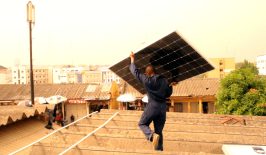Body heat is probably the last thing you think of when you think of Glasgow, Scotland.
However, one Glasgow nightclub made waves recently by announcing its plan to sustainably harness the energy released from its dance floor. Start-up BODYHEAT uses a series of heat pumps and fluids, as well as integrated machine learning to capture the heat generated by SWG3’s partiers, before channelling it into twelve 150m-deep boreholes underneath the nightclub.
The venue currently generates an average annual carbon output of around 70 metric tons — the energy captured from its parties has allowed them to eliminate three gas boilers so far. At full capacity of 1,000+ dancers, SWG3 could generate 800-kilowatts of energy. This energy can then either be used right away to cool down the dancefloor or stored underground for future use.
“We’re hugely excited to reveal our plans to introduce a state-of-the-art renewable heating and cooling system to the SWG3 complex, transforming body heat from clubbers and gig-goers into a source of energy to be used again”, says a statement from the club.
Body heat is a long-neglected source of energy. By doing not very much at all, the human body can radiate around 100 watts of excess heat. This might not sound like a lot, but when you consider a room full of bodies hanging around for the length of a show or event in a confined space, this can quickly add up. For example, in Europe, a 30-square-metre studio using electricity for heating and hot water will consume about 4,350 kWh of energy per year on average. So, just 430 people hanging around for an hour could already power a small home, if the energy was properly harvested.
Lights, Camera, (Climate) Action
And, it’s not just SWG3 that’s taking advantage of this new technology. With a similar capacity, Prague’s historical National Theatre is also finding ways to harness watts, both from excess body heat from patrons as well as heat from spotlights used in its performances. Like in Glasgow, the heat is then typically used to heat or cool the venue.
It works by excess air being passed through a series of heat exchangers. These capture pre-heated air before sending it back into the crowd. According to Jan Míka from the theatre’s technical and operations department:
Previously, this heat was completely dissipated to the outside environment. The heat recovery system allows us to recover some of the heat. The fresh air is then used to ventilate the auditorium and the dressing rooms”, thus reducing the amount of energy needed from external sources.
It’s not just so-called heat recovery technology that’s helping to save Prague’s National Theatre costs and energy use. Solar panels have been installed on the roof and adjacent building. While these currently only provide the theatre with around one percent of its annual energy consumption, this is enough to power up to ten Czech households every year.
Wearables could be moving forward
But what if you didn’t even have to leave the house to generate power? Researchers have started to develop wearable devices, known as thermoelectric generators (TEG), that are small and light enough to be integrated into fabric. This provides the potential for body-heat-powered wearable sensors or temperature-detecting garments, such as face masks, t-shirts or hats. The soft and stretchy material is comfortable to wear and is completely biodegradable.
Wearables such as wristwatches are already being developed that can harvest enough power from body heat to power an LED. The device uses the difference between the temperature of skin and the surrounding environment to create energy, and can withstand 10,000+ uses without losing power or causing any adverse effects to the wearer.
Unlike conventional rigid thermoelectric devices, these new TEGs are low maintenance and long-lasting. However, the technology is currently far from perfect. According to the Institute of Electrical and Electronics Engineers,
“So far, they have relied on expensive or toxic semiconductor materials such as bismuth telluride and lead telluride, and mainly found use in niche applications like spacecraft and satellites.”
Indeed, the materials and designs used to make TEGs so far have resulted in “complex and inefficient [TEGs]… that are too bulky to wear or to fit with other components,” according to Young Min Song, professor of electrical engineering and computer science at Korea’s Gwangju Institute of Science and Technology. However, researchers have been working towards reducing cost and improving efficiency of TEGs.
New technology could be moving in the right direction. Utilization of waste heat could be drastically improved thanks to new research into more economical thermoelectric materials and hybrid energy harvesting devices. Studies have indicated that these developments could be just as efficient as the currently used resources, which are far more scarcely available, used while wasting less energy.
Of course, it’s important to manage our expectations. We’re a long way off from being able to rely on body heat as a main source of energy for our homes and cities — if ever. While using body heat is a novel idea with a lot of potential, perhaps a bigger impact can be made by focusing short-term on the largest producers of waste heat — such as data centres, power stations or car engines. Work is already being done in this area. Data centres in particular are one of the fastest-growing emitters of waste heat, with around 40 percent of their electricity being spent on cooling machinery. The excess heat from Facebook’s servers has already gone on to heat 7,000 Danish homes.
However, the fact that new models and solutions for the utilization of excess thermal energy from our bodies are already out of the development stage and being put into practice is nevertheless exciting. With exposure comes financing, which will in turn spur development. So, maybe we will see cities powered by nightclubs in our lifetimes!









